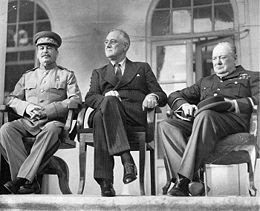 |
THE ALLIES -- STALIN -- ROOSEVELT -- CHURCHILL |
A book review of 'Hunting Evil' by
Guy Walters gives us information how the Allies did not actively pursue the
highest-ranking members of the Nazi Party when they fled the Third Reich. There
is the question, "how could the Allies turn a blind eye which helped Nazi
war criminals to escape?"
One was the most hunted man in the
world, Adolf Eichmann, had been in a cupboard for almost five years in a
mountain hut on the Austrian-German border. He was the architect of the final
solution and had millions of Jews transported to the death camps and killed in
Auschwitz and Treblinka.
Eichmann listened as a
green-uniformed border policeman spoke to the guide who was helping him over
the frontier. Apparently, he lay frozen for what seemed like hours until the
policeman left.
After that, they straight away led
Eichmann down into Kufstein. He went south into Italy, over the Brenner Pass.
He held a Red Cross passport named Richard Klement. After that he
boarded a boat from Genoa and arrived in Argentina weeks later. The Nazi
was breeding Angora rabbits over the decade till the past caught up with them.
It was one of tens of thousand of
Nazis who escaped so easily and very little was done to bring them to justice.
Many Nazis lived in fear of their lives and made sure their escaped. The Allies
did hardly anything to hunt them down. If the Allies really wanted to they
could have hunted them down even after they escape, but they had no intention.
The outlook was that after all the terrible war they wanted to go back home and
rebuilt their country.
British, Canadian and American war
crime units were undermanned and under-equipped. The UN's War Crimes Commission
was an office where the lawyers met and talked and talked.
One point was in the Allies favour
that they underestimated the huge number of crime committed.
It would have taken decades to find
and prosecute about 30,000 of the top Nazis or war criminals. According to the
Allies it would have slowed down the rebuilding of Germany, (Now that is not a
reason after what happened). Furthermore, Winston Churchill said that the
public would start wondering what possible crimes the Allies powers had
committed. (Well, well, what were they hiding?)
By the later '50s Nazi-hunting had
almost stopped. Apart from freelance Jewish operatives as Simon Wiesenthal and
Tuviah Friedman. Both were survivors of the camps and lost all their families.
Friedman was known as a particular
hardliner. Wiesenthal, is hero to many, claiming to have tracked
down 1,100 Nazis. According to the book this story is built on myth and
lies. He built his story to a credulous public. It is assumed that it was more
nearer to 10 Nazis and it doesn't include Eichmann with which he was mostly
credited. Wiesenthal's name was mentioned with the kidnap of Eichmann off the
streets of Buenos Aires in 1960.
However, the operation was ordered by
Mossed, the Israeli secret service but it was never revealed how they located
Eichmann. The fact is that Eichmann was found by a German Jew Lothar Hermann,
who had been blinded by the Nazis in Dachau. He managed to flee to Argentina
before the war. Hermann's daughter had dated one of Eichmann's sons who
unbelievable used still his family's name.
Wiesenthal never travelled to South
America where many Nazis were living. The new generation of hunters were more
adventurous. A well known couple Serge and Beate Klarsfeld contacted corrupt
dictatorships to have the criminals extradited. They also tried to kidnap
former Nazis of the streets in Germany but their amateurish attempt failed.
Apparently, it was not unusual that
they still use their own name. Josef Mengele, the Auschwitz 'doctor' listed his
name in the Buenos Aires telephone book. Franz Stangl, the commandant of
Treblinka extermination camp where 780,000 were slaughtered, was registered
with the Austrian consulate.in Brazil.
Serge and Beate Klarsfeld greatest
success was to find, arrest and prosecuted Klaus Barbie, the terrible Gestapo
chief in Lyon, who had sent many to their death. Barbie was extradited in 1983
from Bolivia and received a life imprisonment in France.
During his trial it emerged the
incredible fact that the US had supervised his escape. Apparently, many Nazis
managed to escape when they collaborated with the Allies. Barbie even worked
for the American and British intelligence Service. (Now I know everything).
Why that happened was that they made
them belief they know everything what is going on behind the Iron Curtain and
that resulted into many enemies became a friend during the Cold War.
Although unbelievable but true, even Wiesenthal paid former SS officers for
information.
Nowadays, it almost has stopped
because so few real top Nazis are still alive and after seven decades it is
almost impossible to bring them to justice being fraught with so many legal
difficulties.
In spite of all, the US has still a
Department of Justice which has a Nazis hunting unit. It extradites those who
did not declare their wartime crimes when they enter the USA.
One Lesson has to be learned from
Nazi-hunting (or not) that age should not be an excuse to do justice. It is a
crime that it was not done immediately after the war when so many could and
should have paid for what they have done.
The Book Hunting Evil by Guy Walters
is available from Bantam
No comments:
Post a Comment